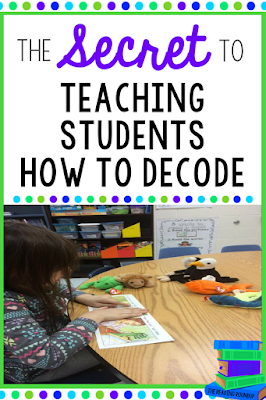Maybe you're already familiar with the Beanie Baby Reading Strategies or maybe you have no idea what I'm talking about. But hopefully by my sharing what has worked for me, you'll find some new ideas to try in your guided reading lessons.
The Beanie Baby Reading Strategies for Decoding
Before I tell you how I use the Beanie Baby decoding strategies, let me first introduce you to our friends!Here's a snapshot of our 9 Beanie Baby Decoding Strategies:
Introducing the Beanie Baby Reading Strategies to Students
I introduce one strategy at a time to provide students with ample opportunities to practice and remember the strategy. With Kindergarten and 1st grade, I typically introduce one strategy a week. This depends on their ability to start implementing the strategy independently. A strategy such as Eagle Eye, typically does not require as much practice. With 2nd graders, I'm able to introduce a couple strategies a week as it is just a review for them.Lips the Fish is the second strategy I introduce as it is also relatively easy for students to begin implementing. Lips the Fish gets his lips ready for the first sound of the word. We practice by covering up the endings of words to use the inital sounds to figure out what the word might be. I also refer back to Eagle Eye if they aren't able to decode the word with just the initial sound. This keeps the previously taught strategy fresh in their mind, but also shows them how the strategies can work together to help us.
Stretchy Snake is one of their favorite strategies! He stretches out the word and helps them sound it out. We practice by stretching out the snake Beanie Baby as we sound out CVC words. I also provide each student with a slinky to practice sounding out the word. Adding this hands on element helps the students internalize the strategy. It is important to remind the students that they must put the sounds together after stretching it out to determine the word (Say C-A-T: cat).
Chunky Monkey is another student favorite! She helps looks for known "chunks" in the words. This can be smaller words within larger words (an is in can), blends/digraphs (sh is at the end of fish), or endings (-s, -ing, -ed). The students will quickly notice that these chunks don't always help them decode the unknown word. (Example: They may notice so and me in some but that does not help them read the word). These words are a great opportunity to teach students how the strategies can work together as well as remind them to think about what word would make sense. (The book There's an Ant in Anthony is a great tool to help with this skill). affiliate link
I typically teach Skippy the Frog and Tryin' Lion together. Skippy the Frog skips an unknown word, while Tryin' Lion encourages students to reread and try a word that makes sense and looks right. I tell students that these are buddies that like to work together. We talk about how we can't skip a word forever because then our story will not make sense. They must go back to reread and try a word that would make sense.
Flippy the Dolphin is the last Beanie Baby I introduce as it requires students to have a knowledge of short and long vowel sounds. Flippy the Dolphin flips the vowel sound. If the word is "pot" we would sound it out with the short vowel sound p-o-t and the long vowel sound p-o-t-e. Then we talk about which word would make sense in the sentence. When we flip the vowel sound, we literally flip the dolphin Beanie Baby as the hands on approach makes it more concrete to the students.
The final Beanie Baby Strategy is Helpful Kangaroo, which teaches students to ask for help. I honestly never introduce this strategy to my students because I want them to independently implement the other strategies and not rely on me to help them with the word.
As I introduce the strategies, I display the posters for students to refer to during guided reading.















No comments:
Post a Comment
Leave a comment